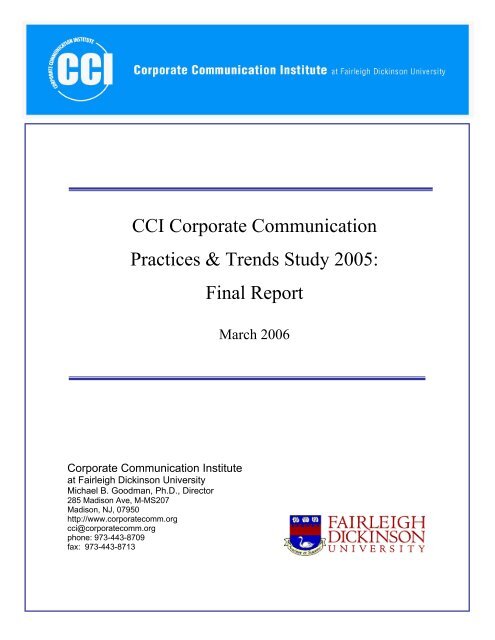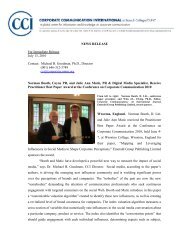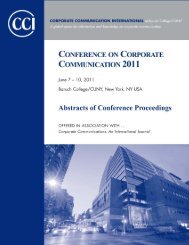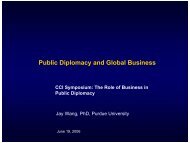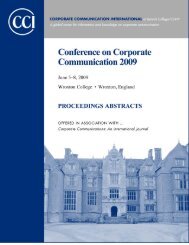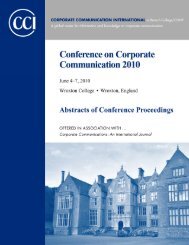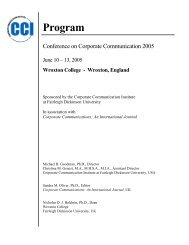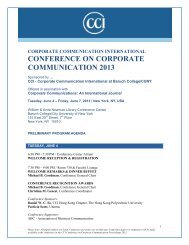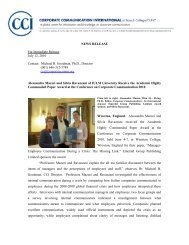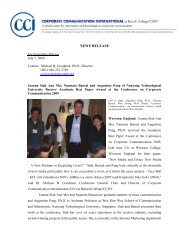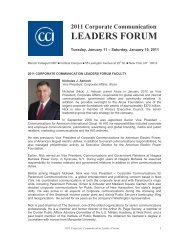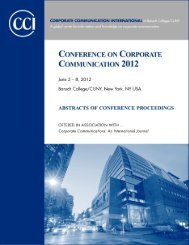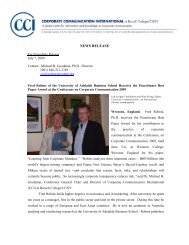CCI Corporate Communication Practices & Trends Study 2005: Final ...
CCI Corporate Communication Practices & Trends Study 2005: Final ...
CCI Corporate Communication Practices & Trends Study 2005: Final ...
Create successful ePaper yourself
Turn your PDF publications into a flip-book with our unique Google optimized e-Paper software.
<strong>CCI</strong> <strong>Corporate</strong> <strong>Communication</strong><strong>Practices</strong> & <strong>Trends</strong> <strong>Study</strong> <strong>2005</strong>:<strong>Final</strong> ReportMarch 2006<strong>Corporate</strong> <strong>Communication</strong> Instituteat Fairleigh Dickinson UniversityMichael B. Goodman, Ph.D., Director285 Madison Ave, M-MS207Madison, NJ, 07950http://www.corporatecomm.orgcci@corporatecomm.orgphone: 973-443-8709fax: 973-443-8713
<strong>CCI</strong> CORPORATE COMMUNICATION PRACTICES & TRENDS STUDY <strong>2005</strong>:FINAL REPORTDr. Michael B. Goodman, DirectorThe <strong>Corporate</strong> <strong>Communication</strong> InstituteatFairleigh Dickinson Universitywww.corporatecomm.orgEXECUTIVE SUMMARYKey Insights (11) of the <strong>CCI</strong> <strong>Corporate</strong> <strong>Communication</strong> <strong>Practices</strong> and <strong>Trends</strong> <strong>Study</strong> <strong>2005</strong>: (1) theneed to build trust with all audiences remains a fundamental challenge for corporations throughrelationships with their internal and external audiences; (2) as budgets increase slowly,responsibilities are increasing more rapidly as companies expect corporate communicators toaccomplish more with less; (3) Anti-Americanism and anti-globalism create a hostileenvironment for multinational corporations and building a responsible and accountable globalcorporate culture is vital to organizational health; (4) communication is now more strategic thanever, as corporate communication executives see “counsel to the CEO” and “manager of thecompany’s” reputation almost equally as their primary role in the company; (5) global issuessuch as outsourcing and terrorism place corporate communication executives as strategiccounsel to the corporation applying an understanding of the global impact of the local act, andthe local impact of the global act; (6) managers are more mature, better educated, and paidmore; (7) news media and technologies are pervasive, instantaneous, and global; transparencyand disclosure laws have made media relations more complex and strategic; (8) the expectationscontinues that the company be a good citizen and make money; (9) global terrorism makes crisiscommunication planning a critical success factor for corporate communication professionals;(10) transparency is becoming a best practice strategy for reputation management; (11) writingremains the core skill for corporate communication.An emerging trend is the role of business in Public Diplomacy. Global companies and theirbrands touch the lives of more people than government representatives ever could. Businesseshave often served a larger role in our society than that of carrying on the activities of commerce.They can serve a diplomatic function because of their intercultural sensitivity, as well as theirunderstanding of the global enterprise they work for and of the world at large. In a world ofinstantaneous media coverage, transparency, and intangible value drivers, successful companieswill welcome the challenge.Since the first <strong>CCI</strong> <strong>Corporate</strong> <strong>Communication</strong> <strong>Practices</strong> and <strong>Trends</strong> <strong>Study</strong> in 2000, the<strong>Corporate</strong> <strong>Communication</strong> Institute has conducted this research to further theunderstanding of current practices in the field, as well as identify the major trends. The<strong>2005</strong> study findings reveal eleven insights, identify the key function and budgetresponsibilities of the corporate communication function, determine the perceived role ofthe chief communication officer, and articulate issues that concern the profession.1
Goals of the <strong>2005</strong> <strong>Study</strong>For <strong>2005</strong> the overall goal of the <strong>CCI</strong> <strong>Practices</strong> and <strong>Trends</strong> <strong>Study</strong> is to outline and analyzethe state of the art for corporate communication in Fortune 1000 companies. With thefirst study in 2000, it was determined to focus on publicly traded companies for severalreasons. First, information in such companies is public and more readily accessible.Second, public companies are often in the vanguard of corporate practices because thepressures of the capital markets, of their need to respond to the media, and the realities ofthe global marketplace. And finally, public companies have a greater understanding thattheir license to operate comes from public approval and is maintained by public trust.This latest study continues the <strong>CCI</strong> Studies from 2000 – 2003. The <strong>Corporate</strong><strong>Communication</strong> Institute determined that the practices and trends study could beconducted every two years, and this cycle of research was implemented with the <strong>2005</strong>research. In years the practices and trends study was not conducted, the focus of <strong>CCI</strong>’sresearch would be on particular issues that have an impact on the profession. Forexample, in 2006 <strong>CCI</strong> embarked on a Benchmark <strong>Study</strong> of the <strong>Corporate</strong> <strong>Communication</strong><strong>Practices</strong> and <strong>Trends</strong> in China.In addition to identifying and analyzing practices and trends in <strong>Corporate</strong><strong>Communication</strong> practices in Fortune 1000 companies, the continuing goal of <strong>CCI</strong>’sresearch is also to build a database for further study. And a major goal of the institute isto benchmark <strong>CCI</strong>’s <strong>Corporate</strong> <strong>Communication</strong> <strong>Practices</strong> and <strong>Trends</strong> <strong>Study</strong> outside theU.S. because of the global nature of corporate practice. And as mentioned that researchis currently being conducted.Background ResearchInformation gathering for this study included evaluation of the findings of The USCAnnenberg Strategic Public Relations Center 2004 GAP III (www.ascweb.usc.edu) whichsurveyed 8500 practitioners from public companies, agencies, and independentpractitioners. The National Investor Relations Institute (NIRI) Center for Strategic<strong>Communication</strong> <strong>Study</strong>, “The Strategic <strong>Communication</strong> Imperative,” (<strong>2005</strong>)(www.niri.org) consisted of 50 one-on-one interviews with the CEO, CFO, the chiefcommunication officer, and the investor relations officer at 11 selected companies. Wealso compared the results of the <strong>2005</strong> research with the <strong>CCI</strong> Studies from 2000, 2001,2002, and 2003 (See www.corporatecomm.org/studies). Information gathered for this<strong>2005</strong> study compared with the previous studies can be found attached to this report in asection titled Survey Data <strong>CCI</strong> <strong>Study</strong> <strong>2005</strong>. It consists of 56 Powerpoint graphs.Methods of the <strong>Study</strong>The <strong>CCI</strong> <strong>Corporate</strong> <strong>Communication</strong> <strong>Practices</strong> and <strong>Trends</strong> research study was carried outin three phases:2
1) a 27-question survey (See Appendix A) that could be completed both on paperor online;2) additional interviews with respondents who filled out the survey and checkedthe box for their willingness to be interviewed;3) site visits with corporate communication executives for a deeper investigationinto their philosophy, processes, operations, and performance measures.1) Survey The survey asked specific information about the company: business sector,total sales in US dollars, number of corporate communication staff worldwide, reportinglines for corporate communication, and the dollar value for corporate communicationactivities related to the budget responsibilities indicated in the survey. Demographicquestions about the chief communication officer were also asked: age, gender, education,salary, company title.Respondents were also asked to indicate which of 26 functional areas for corporatecommunication were included in their responsibility, and which of the same 26 functionalareas were part of their budget responsibility. They were also asked about their expectedchanges in budget and staff from the previous year. They were asked to indicate in whichof the 26 functional areas they used agencies or vendors in a substantial way From 12possible descriptive phrases, they were asked to rank from 1 to 12 the one that bestdescribed the role of corporate communication in their company. There were also openended questions on the impact of anti-Americanism and terrorism, and transparency onthe practice of corporate communication in their corporation. A final question asked foradditional information or comment.The <strong>2005</strong> survey was distributed by mail and the cover letter indicated that it wasavailable online with password access. It was mailed directly by name to the chiefcommunication officer of Fortune 1000 companies in March <strong>2005</strong>, with a follow-uppostcard reminder in April <strong>2005</strong>, a second postcard reminder in May <strong>2005</strong>, and a mailingagain in July <strong>2005</strong>. Also in May <strong>2005</strong>, an additional Email containing the cover letterwith instructions to ask for a paper survey, or to access the online survey, was sent tocorporate members of the Arthur W. Page Society, a membership organization made upof about 300 chief communication officers. The response rate was 9.3%. (Compared tothe 3.7% rate from the GAPIII <strong>Study</strong>, we felt confident in the information we collected).2) Interviews We also completed 16 interviews with those who indicated they wouldparticipate. The interviews consisted of eight open-ended topics. (See the list below onpage 16). They were conducted by telephone and email.3) Site Visits For <strong>2005</strong> we conducted two site visits from August to November <strong>2005</strong>with a corporation in the high tech electronics and communication sector, and the other inthe automotive manufacturing sector. Site visits were selected on the basis of industrysectors that were undergoing change, or a particular company that was doing innovativeprograms in corporate communication, as well as (most importantly) a corporation thatwas willing to participate by allowing <strong>CCI</strong> to visit, observe, and interview the corporatecommunication professionals at the corporate site. For example, a corporate3
communication executive from the transportation sector, specifically railroads, expresseda willingness to participate, but scheduling proved to be a major hurdle. A railroad mightseem an anachronism in the 21 st century, but the interview revealed some very innovativecommunication technologies and processes, thus a good candidate for the site visit.Insights from the <strong>Study</strong>In the discussion of the study we focus on the insights we have drawn from thebackground information, the survey, the interviews, and the site visits. What follows is adiscussion of eleven insights with the trend each one indicates, as well as an opportunityfor future practice.Key <strong>Study</strong> Insight #1*In their comments and in the interviews, corporate communication executives indicated aclear need to build trust with all audiences. This has been so since the 2002 study. Inpractice this means that the corporation’s relationships with external and internalcommunities matter a great deal. Customers, vendors, and business partners need a firmrelationship of trust in the wake of the attack on the World Trade Center, the accountingscandals that followed in the fall of 2001, and the erosion of confidence in the capitalmarkets. “Formal trust,” as I noted in the Journal of Business Strategy (Vol. 26 No.4,2004), “includes the rule of law, transparency, and publicly evident rules. Informal trustis culturally defined by the values and norms that allow people to communicate and dealwith others who share those values.”“Trust is the key objective for global companies today because it underpins corporatereputation and gives them license to operate,” said Michael Deaver, Vice Chairman,Edelman in a note about the Edelman Annual Trust Barometer presented in January 2006at Davos. “To build trust, companies need to localize communications, be transparent,and engage multiple stakeholders continuously as advocates across a broad array ofcommunications channels.”The business case is a simple one -- the license to operate is either granted, or revoked,by the society you are in. This concept is clear for companies in the European Union andthe United Kingdom which emphasize sustainability, or the triple bottom line – financial,environmental, and social performance measures. The trend has become a best practiceamong global corporations -- engage the public, customers, employees, and businesspartners on the social, financial, and environmental accomplishments and actions of thecorporation. A new era of Transparency has created an opportunity for building trustthrough strategic corporate communication initiatives.* Based on responses to Questions 23, 24, 25; Interviews; Site Visits4
Key <strong>Study</strong> Insight #2*Even though budgets for corporate communication increase slowly, as indicated byresponses to Question 15, staff responsibilities increase more rapidly. So following atrend that our research has noted since 2000, and what one communication officerdescribed as “always more to do,” professionals will continue to be asked to be moreproductive as companies continue to expect corporate communicators to accomplishmore with fewer resources. The opportunity is there in this constant escalation of thevolume of work for professional development and cross-fertilization of skills in order tomake each member of a corporate communication staff more capable in all functionalcorporate communication areas. The challenge for communication officers is to developmeasures for corporate communication value – as their corporations turn to variousmeasures, several are developing corporate communication criteria to fit with the“balanced score-card” that their corporations use to judge performance.* Based on responses to Questions 14, 15; Interviews; Site VisitsKey <strong>Study</strong> Insight #3*Respondents when asked open-ended Question #23 responded that Anti-Americanismand anti-globalism create a hostile environment for multinational corporations, makingdaily operations more challenging than ever. The trend toward building a responsible andaccountable global corporate culture is vital to organizational health. Corporations thatoperate globally work hard to harmonize their corporate cultures with the local culture.Look to companies that have operated globally for decades, some for more than 100years for best practices in creating an effective global corporate culture. The opportunityand challenge is for the corporation to address and embrace global issues for competitiveadvantage, and for multi-nationals engage in “Public Diplomacy” to create a stable andpeaceful business environment.* Based on responses to Question 23; Interviews; Site VisitsKey <strong>Study</strong> Insight #4*<strong>Communication</strong> is now more strategic than ever; corporate communication executives see“counsel to the CEO” and “manager of the company’s reputation” almost equally as theirprimary role in the company. A large majority have a seat at the table, withapproximately 75% of communication officers reporting to the CEO (53.8%), the CFO(14%), the COO (3.2%), or the <strong>Corporate</strong> Counsel (5.4%).In this role, the trend toward strategic communication counsel for the corporationaccompanies the role of “Chief <strong>Communication</strong> Officer” (2001, 2002, 2003, <strong>2005</strong>).5
Reporting Lines <strong>2005</strong>[Q#11]%605040302010200120022003<strong>2005</strong>0CEO CFO COO CIO Counsel OtherTop Corp Comm Officer <strong>2005</strong>: VP, SVP, EVP, Dir., MgrAnd other titles: Chief Comm. Officer, VP Global Comm.http://www.corporatecomm.org 36However, a counter trend – a business model that is worth watching -- is emerging. Themodel involves a CEO who sees little value added in communicating with anyconstituency other than a handful of key investors. The role of the communicationofficer is then greatly diminished. As some corporations merge, or as corporatecommunication executives retire and the position is restructured or fragmented. Essentialfunctional responsibilities such as crisis communication and media relations, or legallymandated financial reports, have been decentralized.For the majority of corporate communication executives, with such responsibilities forcorporate decision-making, come great opportunities and challenges to become a trustedadvisor to the corporation and its leaders.* Based on responses to Question 21; Interviews; Site VisitsKey <strong>Study</strong> Insight #5*Global issues -- anti-globalism, outsourcing, terrorism – place corporate communicationexecutives as strategic counsel to the corporation. Often the success of an offshoreinitiative is directly attributed to intangibles such as corporate culture or corporatecommunication. The trend is for corporate communicators to understand the globalimpact of the local act, and the local impact of the global act. The opportunity andchallenge is to move from preaching “global,” to embracing it with stories and messages.In a forthcoming (June 2006) Special Issue on Public Diplomacy of the Journal ofBusiness Strategy is this observation:6
Contemporary business can be a powerful force for global change. A consensusis building that it is proper, and in some cases preferable, for business to marshalits resources to solve problems on a global stage. Business has a considerablerole to play in Public Diplomacy, which was defined in 1965 by diplomatEdmund Guillion, and later Dean of the Fletcher School of Law and Diplomacy atTufts University, as dealing with the influence of public attitudes on the formingand carrying out of foreign policy. And it is an activity in international relationsbeyond traditional political diplomacy that includes actions by governments to“cultivate” public opinion in other countries and to communicate with foreigncorrespondents. It is also the county to country interaction and interculturalcommunication of private groups such as businesses.Substantial agreement now exists that global business can and must act to solveproblems that have often been handled by government. In the decades followingthe end of the Cold War government systematically backed away from issues ofeconomic development, as the “conflicts” at the core of the aftermath of WorldWar II seemed to evaporate along with the fall of the Soviet Union. However, theeconomic and social issues that were masked during the ideological conflict of theCold War surfaced, as did the suppressed desires for political and social ambition.Goodman, Michael B. “The Role of Business in Public Diplomacy,” Journalof Business Strategy, (June 2006) [in press]* Based on responses to Question 23; Interviews; Site VisitsKey <strong>Study</strong> Insight #6*The executives responsible for corporate communication are more mature andexperienced:Age - <strong>Corporate</strong> <strong>Communication</strong>Executives <strong>2005</strong> [Q#7]302520% 151052000200120022003<strong>2005</strong>020-34 35-39 40-44 45-49 50-54 55-59 60-64 65+http://www.corporatecomm.org 357
Ph.DThey are paid more, and at a level appropriate for “C-Suite” decision makers:Salary <strong>2005</strong> [Q#10]3530%252015102000200120022003<strong>2005</strong>50
More corporate communication executives are male:Gender -- <strong>Communication</strong>Executives <strong>2005</strong> [Q# 6]%706050403020100MaleFemale2000200120022003<strong>2005</strong>http://www.corporatecomm.org 41In the management of an effective corporate communication operation, consider the agedifference between managers and staff, approximately 20 years. The difference, ageneration, or the difference between parent and child, highlights the trend thatunderscores success—to embrace diversity as a global asset. The opportunity is forcorporate communication executives to mentor, and to learn from, the next generation.* Based on responses to Questions 6, 7, 8, 10; Interviews; Site Visits.Key <strong>Study</strong> Insight #7*News media and technologies are pervasive, instantaneous, and global. More newsoutlets demand more attention and new tools and techniques to meet the challenges ofBlogs, Really Simple Syndication (RSS) and Consumer Generated Media. Transparencyand disclosure laws and practices have made media relations more complex, andstrategic. One executive says the answer is to “become a ‘glass-box’ company.” Sincethe trend is toward more, not less disclosure of information, expect more demand fortransparency. The opportunity for success lies in how soon a corporation can embracenew communication tools and technologies. The challenge for professionals is how tomanage the messages.* Based on responses to Questions 24, 25; Interviews; Site Visits9
Key <strong>Study</strong> Insight #8*The company is expected to be a good citizen and make money<strong>Corporate</strong> <strong>Communication</strong>Functions & Budget (9) [Q13,16]Philanthropy (Citizenship)%1009080706050403020100Yes - Function No - Function Yes - Budget No - Budget2000200120022003<strong>2005</strong>* Statistics Show If Respondents Own The Function and Its Related Budgethttp://www.corporatecomm.org 53The community your company is in expects a strong and open dialog about what yourcorporation believes, and what it values. A strong relationship of trust closes the gapbetween perceptions of your company and its performance. The trend is that goodcorporate citizenship is expected. The opportunity for success is to build a strongreservoir of trust -- positive reputation equity with all audiences.Business has rediscovered its purpose in this context as global citizen, expanding beyondNobel Prize winning economist Milton Freidman’s definition more than three decadesago that the purpose of business is to create wealth for its owners, within the rules. Theunderstanding of the meaning of “owners” has expanded to include:• NGOs who are also investors• Investors who are also employees• Employees who are also customers• Consumers who are also local business partners• Business partners who are also local stakeholders• Local stakeholders who are also media• Consumers who are also media• Media who are also NGOsAll business, as legendary AT&T executive Arthur W. Page observed more than ¾ of acentury ago, begins with public permission and exists by public approval. And that a10
company’s enlightened self-interest will also cause it to contribute to the social goodwithin its own areas of competency at intersection of society’s needs and its own interest.The intangible risks of not acting as a good corporate citizen and public diplomat can benumerous, such as:• Poor social and environmental performance• An obsession with short term financial performance• Lack of transparency in corporate reporting• Lack of stakeholder engagement• Limited risk management of critical issuesAnd the company’s reputation can be put at risk by:• Lawsuits (Domestic/Abroad)• Negative media coverage• NGO pressure• Consumer boycotts• Eroding public trust• Negative analyst assessment• Market punishmentNow the role of business as citizen reminds us that corporations must act as goodcitizens, or lose their license to operate.* Based on responses to Questions 13, 16, 25; Interviews; Site VisitsKey <strong>Study</strong> Insight #9*Your company will have a crisis; prepare for the ones you can’t conceive of.<strong>Corporate</strong> <strong>Communication</strong>Functions & Budget(10)[Q13,16]Crisis & Emergency%1009080706050403020100Yes - Function No - Function Yes - Budget No - Budget2000200120022003<strong>2005</strong>* Statistics Show If Respondents Own The Function and Its Related Budgethttp://www.corporatecomm.org 5411
The trend toward increased global terrorism makes crisis communication planning acritical success factor for corporate communication professionals. The opportunity to addvalue to the company is through continual crisis planning, as well as professionaldevelopment and cross-functional training through quarterly “crisis drills.”* Based on responses to Questions 23, 24, 25; Interviews; Site VisitsKey <strong>Study</strong> Insight #10*Reputation is an intangible, and a valuable corporate asset. It is difficult to achieve apositive one, but even more difficult to protect. And as Baruch Lev and others haveobserved, more than 50% of the market value of a business can be attributed tointangibles. Indeed, institutional investors now make a substantial percentage of theirdecisions based on the intangibles they see in a corporation.These intangibles drive corporate value: <strong>Corporate</strong> reputation; Governance; Innovation;Research and Development; Environmental and social performance; Brand equity;Human capital; Leadership and strategy; Product and service quality.The trend is that transparency is becoming a best practice strategy for reputationmanagement. The opportunity for corporate communicators is to add value throughoffering constructive suggestions on improving corporate reporting (Sarbanes-Oxley) andcorporate governance.<strong>Corporate</strong> <strong>Communication</strong>Functions & Budget(22)[Q13,16]Reputation Management%1009080706050403020100Yes - Function No - Function Yes - Budget No - Budget2000200120022003<strong>2005</strong>* Statistics Show If Respondents Own The Function and Its Related Budgethttp://www.corporatecomm.org 66* Based on responses to Questions 13, 16, 24, 25; Interviews; Site Visits12
Key <strong>Study</strong> Insight #11*As it has been since the first <strong>CCI</strong> study when we asked interviewees to identify the skillsand capabilities needed for corporate communication, our respondents identify writing asthe core skill for <strong>Corporate</strong> <strong>Communication</strong>. Also an essential skill is a thoroughknowledge of the company and of business principles. The skill set necessary for successas a corporate communicator in a global business environment also includes:• Integrity & Honesty• Global mindset; objective perspective• Business orientation; Project management• Critical & analytical thinking; problem-solving; synthesizing• <strong>Communication</strong> & Media skills; Listening; Persuasion• “Grace under pressure” – Confidence, composure, compassion• Resilience; Positive attitude• Energy, discipline, passion• Leadership; Team player• Intelligent; Innovative; Creative• Social-ability; Emotional Intelligence• Mentoring & Coaching; Quick study• Strategic thinkingA clear opportunity for corporate communicators to bring value to their companies lies inthe text-based nature of new media technologies.* Q 25; Interviews; Site VisitsKey Functional Responsibilities of <strong>Corporate</strong> <strong>Communication</strong> OfficersIn our survey we asked [Question #13] what functions, of the 26 listed, were includedunder corporate communication officer’s responsibilities. Not surprisingly more than90% of the people who responded to the survey included these areas:• Media relations• Public Relations• Crisis <strong>Communication</strong>• Executive <strong>Communication</strong>• Employee Relations• <strong>Communication</strong> Policy and Strategy.The functional responsibilities listed in Table 1 offer a clear outline of the major strategicrole played by corporate communication in developing and maintaining essential internaland external relationships with key audiences. Each function was listed by more than50% of the respondents.The development of positive internal relationships is critical for building a positivecorporate reputation. Successful reputation management pays particular attentiondeveloping and maintaining a positive attitude among management staff and employees.13
Functional Area• Media Relations* --• Public Relations* --• Crisis <strong>Communication</strong>* --• Executive <strong>Communication</strong>s (Speeches)* –• Employee Relations (Internal <strong>Communication</strong>)*–• <strong>Communication</strong> Policy and Strategy* –• Internet Site –• Intranet Site –• Identity –• Issues Management –• <strong>Corporate</strong> Citizenship (Philanthropy) –• Advertising –• <strong>Corporate</strong> Culture –• Investor Relations –Percent responsible95.7%95.7%93%92.5%90.3%90.3%87.1%82.8%73.1%71%59.1%55.9%48.4%25.8%* Almost ubiquitousTABLE 1 Strategic Functional Areas Managed by <strong>Corporate</strong> <strong>Communication</strong>ProfessionalsThe Perceived Role of the <strong>Corporate</strong> CommunicatorBeginning with the 2001 survey we asked (Question #21) the corporate communicationexecutives to rank descriptions (from 1 – 8 in 2001, and from 1 -12 in 2002, 2003, <strong>2005</strong>)that best described the way they themselves thought of the role of corporatecommunication in their company:_____ Advocate or "engineer of public opinion," in support of the company's policies_____ Branding and brand perception steward_____ <strong>Corporate</strong> philanthropy (citizenship) champion_____ Counsel to the CEO and the Corporation_____ Driver of company publicity_____ Manager of the company's image_____ Manager of the company's reputation_____ Manager of employee relations (internal communication)_____ Manager of relationships between the company and ALL of its key constituencies_____ Manager of relationships between the company and its key NON-CUSTOMERconstituencies_____ Source of public information about the company_____ Support for marketing & sales_____ Other: ______________________________________________________Table 2 presents the descriptions our respondents ranked first.14
2001Percent of Respondentswho RANKED thefollowing functions #1:2002Percent of Respondents whoRANKED the followingfunctions #1:2003Percent of Respondents whoRANKED the followingfunctions #1:<strong>2005</strong>Percent of Respondents whoRANKED the followingfunctions #1:20.0 % - Manager ofcompany’s reputation15.1% - Source ofpublic information aboutthe company14.1% - Manager ofrelationships (Co. &Key non-customerconstituencies)13.8% - Advocate or“engineer of publicopinion”12.4% - Manager ofthe company’s image11.9% - Driver ofcompany publicity11.4 % - Manager ofrelationships -- co. &ALL key constituencies2.7% - Support formarketing & sales8.1% - OtherNote: Four New OptionsFor 200221.6% - Counsel to the CEO& the Corporation (new-2002)18.0% - Manager ofcompany’s reputation15.3% - Manager of employeerelations (internal comm.)(new-2002)12.6% - Source of publicinformation about thecompany12.6% - Manager ofrelationships – co. & NONcustomerconstituencies9.9% - Manager of thecompany’s image8.1% - Driver of companypublicity7.2% - Manager ofrelationships -- co. & ALLkey constituencies7.2% - Advocate or“engineer of public opinion”6.3% - Branding & brandperception steward (new-2002)4.5% - Support for marketing& sales2.7% - <strong>Corporate</strong>philanthropy (citizenship)champion (new-2002)0.9% - Other18.4% - Manager ofcompany’s reputation17.5% - Counsel to the CEO& the Corporation (new-2002)14.6% - Advocate or“engineer of public opinion”10.7% - Manager ofrelationships – co. & NONcustomerconstituencies9.7% - Manager of thecompany’s image8.7% - Source of publicinformation about thecompany7.8% - Manager ofrelationships -- co. & ALLkey constituencies5.8% - Driver of companypublicity5.8% - Branding & brandperception steward (new-2002)3.9% - Manager of employeerelations (internal comm.)(new-2002)1.9% - Support for marketing& sales1.9% - Other1.0% - <strong>Corporate</strong>philanthropy (citizenship)champion (new-2002)19.4% - Counsel to theCEO & the Corporation(new-2002) [17.2% #2]20.4% - Source of publicinformation about thecompany [10.8% #2]20.4% - Manager ofcompany’s reputation [9.7%#2]17.2% - Advocate or“engineer of public opinion”9.7% - Manager of thecompany’s image8.6% - Driver of companypublicity7.6% - Manager ofemployee relations (internalcomm.) (new-2002)7.5% - Branding & brandperception steward (new-2002)5.4% - Support formarketing & sales4.3% - <strong>Corporate</strong>philanthropy (citizenship)champion (new-2002)4.3% - Manager ofrelationships -- co. & ALLkey constituencies1.4% - Other1.1% - Manager ofrelationships – co. & NONcustomerconstituenciesTABLE 2 Chief <strong>Communication</strong> Officer’s Perception of the Role of <strong>Corporate</strong><strong>Communication</strong> in Companies -- 2001, 2002, 2003, <strong>2005</strong> in Response to Question #21“Counsel to the CEO” was added to the choices in 2002. It and “manager of thecompany’s reputation” have ranked one or two in every study since 2002. In <strong>2005</strong> weplaced “counsel to the CEO” at 19.4% above “manager of company’s reputation” and“source of public information about the company” both at 20.4%, because of thepercentages each was ranked at number 2 – respectively: 17.2% “counsel to the CEO”;10.8% “manager of the company’s reputation”; 9.7% “source of public informationabout the company.”15
Also note that “advocate or ‘engineer of public opinion,’” a description we included toreflected the way Edward Bernays and Ivy Lee practiced Public Relations over 50 yearsago, has moved from 7.2% in 2002 to 14.6% in 2003, and to 17.2% in <strong>2005</strong>. It could bethat contemporary corporate communication practitioners see themselves having greaterinfluence on the way others see them, thus the ranking of reputation and “engineering”public opinion.Interview Questions and ResponsesAt the end of the survey Question 26 asks if respondents are willing to take part in afollow-up interview to discuss the nature of corporate communication in their company.Eight open-ended topics are sent by e-mail with the option to have a telephone interviewor send their comments by return e-mail:• The top three critical issues in corporate communication• Strategic importance of corporate communication in your organization to you; toyour CEO• Top three trends in corporate communication• <strong>Trends</strong> unique to your corporation’s industry or sector• <strong>Corporate</strong> communication contribution to overall success of the corporation• Core competencies: for individual practitioners; for the corporation as a whole• Impact of transparency and disclosure on the relationship between ethics andadvocacy in the practice of corporate communication• Additional commentsMany corporate communication executives are concerned with how to measure anddemonstrate the effectiveness and value of the communication function to the corporationas a whole. There is, according to one executive, an “ongoing need to engage businessleaders in communication strategy before events occur so that we can be proactive(contribute to the business strategy) and not just react to the story from a communicationperspective.”They are challenged by an increasingly global environment, and the need for “creatingrelevant global messages; delivered locally in context.”They understand important issues presented by “the changing face of media relations –24x7 factor of global media,” and the challenge of “staying on top of, understanding, andlearning to leverage new and changing communication mediums (blogs, pods, chatrooms, instant messaging …)” and of “real-time” news coverage.Here are some of the verbatim responses from the interviews grouped by issues:Impact of Terrorism: It was still as much a surprise in <strong>2005</strong> as it was in 2002 that wereceived more than 15 responses like this:“Minimal impact, if any” and “Very little impact.”16
Comments on the Impact of Terrorism such as these from corporate executives in theFinancial Services sector were more informative:“Substantial impact. Specifically because we were identified as a possible targetand because we have numerous locations in foreign countries.”“It has not prevented us from being successful, but as a large, very public andglobal brand, we can always be a target.”As well as these comments on the impact of terrorism:“… large issue in the hospitality industry … our hotels are public and privatespaces whose doors are open 24/7 and large groups congregate.”“… producing a new crisis communications plan that includes elements ofterrorism.”“Increased security has created communications challenges.”“As…owner of U.S. nuclear plants, we have seen plant security become a muchlarger issue for us, both externally and internally.”Transparency was a major concern as illustrated by these comments:“Transparency has been critical in driving our credibility and leading the chargeon encouraging and enabling employees to blog has been a part of thistransparency.”“Minimal. Company has long been committed to open communication.”“Not much … We’re regulated and transparent already.”“We have always been open, but even more so now.”“Greater frequency and depth of press releases, particularly earnings statements.Greater use of Webcasting.“<strong>Communication</strong>s are less crisp and clear – and more legalese.”“Extensive … Sarbanes-Oxley has added significantly to our work load.”“Created a much larger paperwork burden…On the other hand, …significantadvantages for our image and reputation.”Several comments addressed the necessary capabilities for corporate communicators:“Trying to keep pace with changing technologies.”“Still struggle to come up with effective measurements that are truly valuable andeasy to implement.”17
“Remains a “critical” part of the corporation.”“Spread thin, do the best with resources we’re given. Always more we can do toadd value to the organization.”Comments on corporate communication Strategy illustrated its importance:“Becoming more policy-oriented.”“Transparency has been a key driver of our communications strategies, bothexternally and internally. We have devoted considerable resources to improvingand expanding upon our disclosures and to becoming a “glass-box” company.”“The CEO, COO, CFO, and General Counsel are the main engineers of corporatecommunications and do the job directly themselves.”Other comments highlighted the Value of the corporate communication function:“Its role has become more essential than ever to the success of business overall.The importance of this function is a fairly recent change and is now fullyingrained in the daily practice of the most successful businesses.”“While the function has made great strides at getting the proverbial seat at thetable, we still need – particularly in Fortune 100 companies – to have aninstitutionalized seat at the table, like legal or finance.”“CC has gained in importance for us. We have executed a remarkable turnaroundand the interrelationship between improved business performance, increasedexternal coms., & increased employee pride has been critical.”“In our organization, the Global <strong>Communication</strong>s Department is centralized andsupports virtually every business and corporate function by providingcommunications counsel and execution.”Observations from Site VisitsSite visits were conducted with a corporation in the high tech electronics andcommunication sector (several visits in August to November <strong>2005</strong>), and one in theautomotive manufacturing sector (one visit in September <strong>2005</strong>). The two industry sectorsare of interest because of their global nature, their economic impact, and their maturity asa sector. Each site visit allowed an opportunity to observe and to interview the team ofcorporate communication professionals. All interviews were open-ended andconfidential. Interviews began with a statement that <strong>CCI</strong> was interested in a“conversation” with them about what they do, what their challenges were, and what theywere proud of – and a clear assurance that their comments would be kept anonymous.18
Each corporation was well aware of the daunting challenges of their respective industries.Each was concerned with developing performance measures -- one based on the“balanced scorecard”; and the other a corporate “Image Barometer” and a corporateequity measure. One corporation had a “Manager of <strong>Communication</strong> Intelligence,” thatwas created to parallel a similar manager of “Market Intelligence,” to collect and analyzeexisting data from inside and outside the company. The goal is to create a single tool tomanage the corporate brand – product brands, reputation, internal communication.Both companies had professional and effective crisis communication, media relations,and corporate citizenship policies and plans. Both chief communication officers hadcreated teams of highly talented, motivated, and professional experts who were crosstrained.Each corporation had a global mind-set and had created an effective internalnetwork to help one another and to share information.The chief communication officer and the members of the team in both corporations werewell versed in the company business from R&D to labor relations to the internet andintranet sites. And each had the corporate communication skills that are described onpage 13 above. And members of the teams genuinely liked the work they were doing, thepeople they were working with, and the corporation they worked for.The Value of <strong>Corporate</strong> <strong>Communication</strong>The corporation is profoundly different than it was a hundred years ago-- a vehiclecreated to acquire and manage enough capital so that owners could build the hardware torun a plant and to maintain a manufacturing operation. Do people who want to makemore money need a corporation with shareholders? There are many successful companiesthat don't make anything, even though they sell hardware products, because they've gotvendors doing it for them. With all the capital markets today, owners don't need the kindof investment in facilities to get more money to expand.A contemporary corporation is a way of harnessing and focusing human capital. It iscapable people with smart ideas, who know how to innovate and run things. It's aboutpeople, and a network of people. Individual corporations are powerful because of theiralliances.When there is a question or concern, people expect responsiveness from the corporation,and speed and transparency in its communications. In a crisis it is the corporation thathas to step up, not its products or brands.The role of corporate communication is fundamental to the success of the corporation.19
SELECTED SOURCES<strong>CCI</strong> <strong>Corporate</strong> <strong>Communication</strong> <strong>Practices</strong> and <strong>Trends</strong>, 2000, 2001, 2002, and 2003.www.corporatecomm.org/studiesEdelman Press Release: “A Person Like Me” Now Most Credible Spokesperson forCompanies; Trust in Employees Significantly Higher Than in CEOs, EdelmanTrust Barometer Finds Survey Shows Microsoft as Most Trusted GlobalCompany and Technology Most Trusted Sector; Television, Not Newspapers,Loses Ground to Internet as Trusted Source. NEW YORK, January 23, 2006.Goodman, Michael B. “Restoring Trust in American Business: The Struggle to ChangePerception, Journal of Business Strategy, Vol 26, No. 4 (<strong>2005</strong>), pp. 29 – 37.Goodman, Michael B. “The Role of Business in Public Diplomacy,” Journal of BusinessStrategy, (June 2006). [in press].The National Investor Relations Institute (NIRI) Center for Strategic <strong>Communication</strong><strong>Study</strong>, “The Strategic <strong>Communication</strong> Imperative,” (<strong>2005</strong>) www.niri.org“Restoring Trust in Business: Models for Action,” PR Coalition White Paper, September2003 www.corporatecomm.org/pdf/PRCoalitionPaper_9_11<strong>Final</strong>.pdfThe USC Annenberg Strategic Public Relations Center, 2004 Generally Accepted<strong>Practices</strong> (GAP) III <strong>Study</strong> www.ascweb.usc.edu and www.prfirms.org20
ABOUT THE AUTHORMichael B. Goodman, Ph.D. is the founder and director of the <strong>Corporate</strong> <strong>Communication</strong>Institute, and Professor of <strong>Corporate</strong> <strong>Communication</strong> at Fairleigh Dickinson University,serving as director of Graduate Programs in <strong>Corporate</strong> <strong>Communication</strong> for sixteen years.He has taught business and corporate communication courses at Bangkok University(Thailand), Baruch College CUNY, New York University, New York Institute ofTechnology, Northeastern University, and SUNY at Stony Brook. Since 1981 Dr.Goodman has been a consultant in corporate communication, managerial communication,problem solving, new business proposals, change, and corporate culture. He haspublished widely, most recently: Work with Anyone Anywhere: A Guide to GlobalBusiness; “Today’s <strong>Corporate</strong> <strong>Communication</strong> Function” in Handbook of <strong>Corporate</strong><strong>Communication</strong> and Strategic Public Relations; <strong>Corporate</strong> <strong>Communication</strong> forExecutives. He is at work on "While You Were Looking the Other Way -- ForcesRedefining <strong>Corporate</strong> <strong>Communication</strong> Strategy” with Cleve Langton and Peter Hirsch.He is a member of the Arthur W. Page Society, a Fellow of the RSA (The Royal Societyfor the encouragement of Arts, Manufactures & Commerce), and a Fellow of The Societyfor Technical <strong>Communication</strong>. He is VP Eastern Region and Member of the Board ofDirectors of the Association for Business <strong>Communication</strong>. He received his BA from theUniversity of Texas at Austin, and his MA and Ph.D. from the State University of NewYork at Stony Brook.21
With deep appreciation to <strong>CCI</strong>’s <strong>Corporate</strong> SponsorsAccentureAllstate Insurance CompanyAssurantHenry Schein, Inc.J.M. Huber CorporationJohnson & JohnsonLucent TechnologiesPfizer IncPrudential Financial, Inc.TIAA-CREFWyethfor their investment in our mission and our work<strong>Corporate</strong> <strong>Communication</strong> Institute at Fairleigh Dickinson University...The first choice for information and knowledge on corporate communication285 Madison Avenue, M-MS207, Madison, NJ 07940Phone: 973-443-8709 • Fax: 973-443-8713cci@corporatecomm.org22
http://www.corporatecomm.org23


